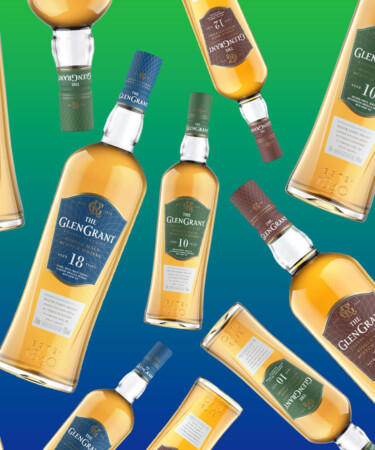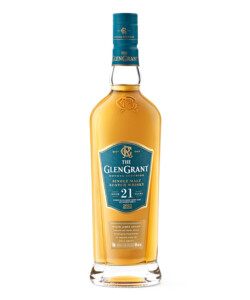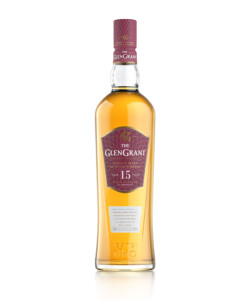Standing out among skilled Scotch producers for its light and approachable flavor profile is The Glen Grant, founded in 1840 by brothers John and James Grant. Today, the Speyside distillery is the only remaining single malt distillery to still bear the name of its original founders. Prior to the legalization of Scotch whisky production, John was a notorious whisky smuggler, while trained solicitor James was known for having helped lead the Raid on Elgin, the last Scottish clan revolt in history. Once whisky production was legalized in 1823, John began selling legal whisky around Speyside. Soon after, the brothers agreed to enter the distillery business, and they took over the lease of an Aberlour distillery that was set to expire in 1840. Once it did, the distillery was named The Glen Grant, and the brothers began producing approximately 1,500 gallons of Scotch per week (approximately 78,000 gallons per year).
The formation of The Glen Grant would be a catalyst for a number of Scottish distilleries to open, mainly as James Grant was the founder of the Morayshire Railway Company. The railway company operated train lines from the port of Lossiemouth to Elgin, which made it much simpler to transport supplies and construction materials into the region and whisky out of it.
Today, The Glen Grant produces over 1.5 million gallons of Scotch per year with water sourced from two nearby natural springs and native Scottish barley from the Spey Valley, one of the most fertile barley regions in the world. The distillery has released dozens of expressions for whisky lovers to try, one of which is one of the oldest Scotches to ever hit the market. Now that you know the basics, here are nine more things you should know about The Glen Grant.
-
In the 1870s, The Glen Grant got some ‘Major’ upgrades.
In 1872, The Glen Grant was inherited by John Grant’s nephew (also named James Grant), who became known as “The Major.” The Major was a revolutionary who was endlessly fascinated by technological innovation: He was the first man in the Scottish Highlands to own a car, and was the person to bring electricity to The Glen Grant, making it one of the first distilleries to do so. In addition to putting the distillery on the electrical grid, The Major also introduced a water-cooling purifier, making The Glen Grant the first distillery to utilize a purifier when producing whisky. Through this system liquid is chilled continuously, which leads to increased levels of condensation and helps to create the malty flavor and clear coloring that the distillery is known for.
-
The stills used to distill the brand’s Scotch were quite groundbreaking when they were introduced.
In addition to his other advancements, The Major also developed specialized elongated pot stills to capture the vapors that emanated from the cooling process. Whereas many Scotch distilleries utilize shorter, squat stills, those utilized by The Glen Grant are broad at the bottom and open to a narrow neck. which the distillery says aids in providing the Scotch with its signature light taste. The Glen Grant currently utilizes eight stills: four wash stills and four spirit stills that operate at a 15,100 liter capacity and 9,600 liter capacity, respectively. The distillery stands out among other Scotch distillers as the only one to use a cooling purifier on both wash and spirit stills.
-
There’s a famous Victorian-era garden on distillery grounds with a secret whisky stash.
In addition to being known around Speyside as what we can only imagine to be the local tech bro, The Major was also known for being quite the extensive traveler thanks to his time serving in the British army. To show off the fascinating plants and exotic fruits he discovered while on his expeditions in Africa and India, he constructed the Glen Grant Garden in 1886, complete with a hut called the Dram Pavilion where The Major intended for his spirits to be drunk and enjoyed. Today, the Glen Grant Garden spans 22 acres and is home to orchards, meadows, and gorges. The garden is also home to a cave (now known as Major’s cave) for the private barrel of The Glen Grant Scotch whisky locked inside it.
-
Whiskies distilled by The Glen Grant are aged in ex-bourbon and ex-Spanish sherry casks.
The Glen Grant has released dozens of expressions in its 183-year history, each of which has been aged in ex-bourbon and ex-Spanish sherry casks hand picked by master distiller Dennis Malcolm. Each barrel is reused by the distillery no more than three times to ensure flavors from the casks are still able to permeate the distillates inside. The distillery currently has seven warehouses on site where 11,500 ex-bourbon barrels filled with maturing Scotch whisky are resting, in addition to numerous off-site warehouses where its sherry-aged whiskies are housed. The combination of Glen Grant’s unique distillation practices and maturation techniques result in light, smooth Scotch whiskies with lingering floral, honeyed fruit, and spiced notes.
-
Master distiller Dennis Malcolm was actually born on the distillery’s grounds.
The Glen Grant’s current master distiller, Dennis Malcolm, started his career in whisky production over 60 years ago, though his life has been tied to Scotch since the moment he was born. In 1946, Malcolm was delivered on the grounds of the distillery where his father and grandfather both worked. Malcolm himself started working at the distillery at the age of 15 as an apprentice cooper, where he spent years learning the craft of making casks. Come 1971, he was in his mid-20s and was operating The Glen Grant distillery as a production brewer. While he went on to take his expertise to The Glenlivet distillery for a time, he would eventually find his way back to The Glen Grant. Following Seagram’s acquisition of the brand in 1978, Malcolm began overseeing production of each of the parent company’s Scotch whiskies: The Glen Grant, The Glenlivet, Longmorn, Caperdonich, and Benriach. He also had a hand in running Chivas’s nine malt distilleries in the ‘90s, and managed the Benriach distillery in the early aughts before returning to The Glen Grant as master distiller in 2006 when the brand was acquired by the Campari Group. With over six decades of experience in the industry, Malcolm is one of Scotland’s longest-serving and most renowned distillers.
-
The Glen Grant produces three distinct collections of whisky.
The Glen Grant produces a number of unique expressions, each of which falls into one of three collections: the Principal Collection, the Exclusive Collection, and the Archive Collection. The Principal Collection houses the distillery’s core expressions, including its flagship 10 Year Scotch Whisky. Joining the 10 Year is a 12-year-old, a 15-year-old, and an 18-year-old Scotch whisky that are all aged in ex-bourbon casks; a newly released 21-year-old Scotch matured in ex-oloroso sherry and ex-bourbon barrels; and Arboralis, a non-age-statement Scotch aged in both ex-bourbon and ex-sherry casks. The Exclusive Collection, which is only available in travel retail markets, currently includes The Glen Grant 12 Year Old Non Chill-Filtered and Rothes Chronicles Cask Heaven, both of which are aged in bourbon and sherry casks at Speyside’s Dinnage Warehouse No. 4, which was designed by The Major himself.
The Archive Collection is easily its most premium, and currently includes six of the distillery’s most coveted special-edition single malts. Among these expressions are The Glen Grant 25 Year, 50 Year, and 60 Year, as well as V Decades , which was crafted by master distiller Dennis Malcolm for his 50th anniversary in whisky, the 170th Anniversary Edition released in 2010 to celebrate of distillery’s founding, and the Sept. 2023 release of Devotion 70, one of the oldest Scotch whiskies to ever hit market.
-
The distillery is part of the Malt Whisky Trail in Speyside.
Similarly to Kentucky’s iconic Bourbon Trail, Scotland is home to a whisky trail of its own: the Malt Whisky Trail, which takes adventures on a journey to nine active and historic distilleries in the Speyside region. In addition to stopping by The Glen Grant for a distillery tour, those journeying down the Malt Whisky Trail also have the opportunity to visit operational distilleries like Benromach, Cardhu, Glen Moray, Glenfiddich, The Glenlivet, and Strathlisa, as well as the now-shuttered Dallas Dhu distillery and The Speyside Cooperage.
-
The brand’s Scotch is beloved by the royal family…
Not only is The Glen Grant enjoyed by consumers worldwide, but it is also a favorite of the royal family, which has long been entrenched in the world of Scotch whisky production. In 2013, The Glen Grant distillery opened a new bottling hall with the help of King Charles, nearly a decade before he would succeed Queen Elizebeth II following her passing. As The Glen Grant is the only distillery in Speyside to bottle all whisky on-site, this new bottling hall allowed for the distillery to expand its production. In her lifetime, Queen Elizabeth II was herself a fan of the whisky, and she named Dennis Malcolm an Officer of the Most Excellent Order of the British Empire — a title that honors those who have served in non-combat roles to contribute to the arts, sciences, public service, or charitable work — for his work in the Speyside community.
-
…and in September 2023, the distillery released its oldest Scotch to date as a tribute to Her Majesty.
During her 70-year reign, Queen Elizabeth II was known for her love of Scotch, likely developing a taste for the spirit while residing at Balmoral Castle, the royal family’s summer home in Aberdeenshire, Scotland. In September 2023, The Glen Grant released its oldest whisky yet: Devotion 70, a 70-year-old Scotch the brand says was inspired by Her Majesty the Queen’s years of dedication to her people. The whisky was distilled in 1953, and was transferred into a singular oloroso sherry-seasoned French oak butt on September 1 of that year. According to the brand, the Scotch — which is bottled at 55.5 percent ABV — carries floral aromas accompanied by whiffs of barley sugar and ripe peach with a palate of dried fruit, sultana, dry spice, and a hint of oak. Just seven decanters of the Scotch were produced, each of which is engraved with an image of a lily of the valley (the former queen’s favorite flower) and a thistle (Scotland’s national flower). The first decanter was sold at Sotheby’s in late September, fetching an impressive $101,300, every dollar of which was donated to the Royal Scottish Forestry Society where Queen Elizabeth II was a member. The remaining six decanters are available for sale in the U.S. and Asia.


